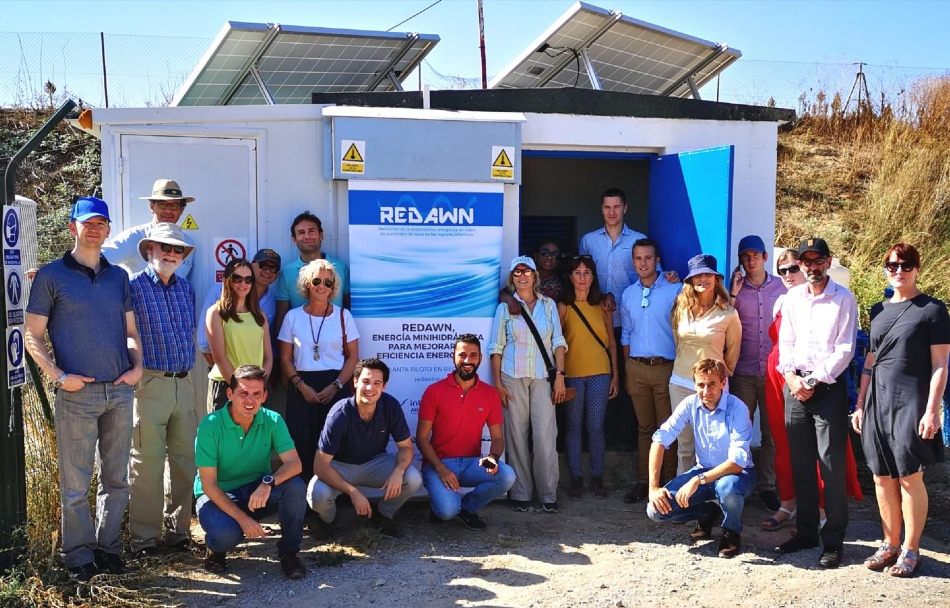May 28 2020
As well as requiring a huge amount of water, irrigation agriculture involves the use of a considerable amount of energy, which negatively impacts the environment and poses a heavy financial burden for the agricultural sector.
 Image of the international group of researchers of the Redawn project, at a meeting in late 2019. Image Credit: University of Córdoba.
Image of the international group of researchers of the Redawn project, at a meeting in late 2019. Image Credit: University of Córdoba.
A study by the Hydraulics and Irrigation research group at the University of Cordoba and Trinity College Dublin reports that recovery of energy from water distribution networks for irrigation could lead to a 12.8% annual saving of energy.
This data was retrieved from a prediction model that investigates the potential of this new technology in the provinces of Cordoba and Seville. The system acquires energy using the excess pressure in water distribution networks and makes use of pumps as turbines to produce electricity.
The research group performed 177 observations of 18 irrigation networks and analyzed the distinct variables such as the crop water requirements, the irrigated surface area, topographic slope, rainfall, and hydraulic configuration of the distribution system.
With the help of artificial intelligence methods, the researchers were able to infer the results for over 164,000 hectares of the irrigated surface region. This study forms part of the research outcomes for researcher Miguel Crespo’s doctoral thesis studies. His advisors include Professors Juan Antonio Rodríguez and Jorge Garcia.
Based on the data received, the usage of energy recovered from the 2018 season would have meant a savings of 21.05 de GWh (Gigawatt hours) in both the provinces, which is equal to a savings of 12.8% for the energy used by these irrigation systems during the season being reviewed.
This technology could be a crucial financial relief for water user associations because, as per the data obtained from the research group, the cost of energy forms 40% of the total cost of water on an average.
Besides saving energy, this system could offer a competing benefit as it decreases the carbon footprint of the crops, which is valued highly by consumers. Still, as researcher Juan Antonio Rodríguez points out, the main advantage of the technology is that “energy for irrigation could be obtained in places where there is no electricity available,” and in locations where diesel generators are predominantly used for energy supply.
However, this new irrigation system, which can be repaid in 5 or 6 years as a result of energy savings (quicker than conventional turbines), has a few drawbacks.
The pumps that function as turbines and use excess water pressure to produce energy, called PATs (or pump as turbines), “are efficient within a fairly limited range of flow levels, so the fluctuations common in irrigation networks could lower their performance,” though “this issue could be sorted out by means of hydraulic regulation elements that would make a PAT work near its optimal performance point,” noted Professor Juan Antonio Rodríguez.
The goal of the researchers is to reap higher benefits from this system. Therefore, they continue to work toward the goal within the framework of the international project known as Redawn (decreasing the energy dependency in Atlantic water networks), an initiative for water use and energy efficiency with the aim to promote the implementation of this hydroelectric energy-recovering technology in the Atlantic region’s water distribution networks.
The project forms part of the “Interreg Atlantic Area” program and visualizes installation of an industrial water distribution network pilot plant in Portugal, another one for provision to urban regions in France, and the third one for irrigation networks installed in a water users association in the town of Palma del Río (in the province of Cordoba, Spain), that started its functions in April 2019 and has helped to permanently avoid the use of diesel generators.
Journal Reference:
Chacón, M. C., et al. (2020) Estimating regional potential for micro-hydropower energy recovery in irrigation networks on a large geographical scale. Renewable Energy. doi.org/10.1016/j.renene.2020.03.143.